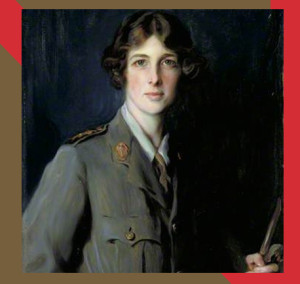Edith Vane-Tempest-Stewart (3 December 1878 – 23 April 1959), Marchioness of Londonderry, was an enigmatic and forward thinking woman for her time. During a period when women’s political allegiances were linked to their husband’s parliamentary views Edith sought to contradict the views of her husband, Charles, Marquis of Londonderry, on the issue of women’s suffrage. Edith actively supported local suffrage groups in the North of Ireland but hesitated to support the more violent suffragette actions of the Irish Women’s Franchise League. Edith was also a firm believer in the equal position of women and if given the chance women could flourish in industries that they were denied access or little involvement with. Particularly, Edith was adamant that women could be excellent journalists, doctors, engineers, accountants and lawyers.
Edith’s admiration for the role women could play if given the chance came to fruition in WWI when she helped set up the Women’s Legion. This eventually led to the establishment of the Women’s Land Army, The Women’s Voluntary Service and the Women’s Army Auxiliary Corps, as people saw that women could do the same jobs as men. The Women’s Legion provided kitchen staff, drivers, clerical staff, nurses etc. to various businesses, government departments and the British Army and Royal Navy. From the very beginning Edith was adamant that the members of the Women’s Legion should have a smart and respectable uniform as part of the Women’s Legion. This was to combat any allusions by the media that women were incapable of doing war work because of their tight, constrictive corsets and long, impractical skirts.
This prompted Edith to have a useful uniform designed along the lines of the male officer’s dress uniform in the British Army. The Women’s Legion uniform consisted of an above ankle skirt, khaki double breasted jacket with functional pockets, a Boy Scout’s hat and sturdy boots. This uniform enabled members of the Women’s Legion to take on their increasingly demanding roles within the Legion and to prove to men that they could do similar jobs. Dr. Margaret Ward has argued that Edith is quoted as saying that her women would be smarter than any other women’s service, as to let go of fashion and femininity is to play into men’s controlling hands. Dr. Ward is trying to state that Edith was aware that the members of the legion must still appear feminine to be “accepted by the male establishment.”
If we look closer at links between fashion history and social history, we can see that female WWI uniforms tell us a lot of how women were perceived in this era.There are numerous photographs of women in Nurse’s and Military Uniforms that tell us that these women were respected for their role through their efforts and the dress that they wore. This is particularly true in that Edith, Marchioness of Londonderry, was awarded the first Military Order of the British Empire ever given to a female for her efforts in the establishment of the Women’s Legion. Edith is an inspiration to generations of young girls and women to not be afraid of what you believe in, even if it goes against popular opinion. Additionally, to truly believe and dedicate yourself to a cause, like Edith, is being true to yourself and your personal identity.

